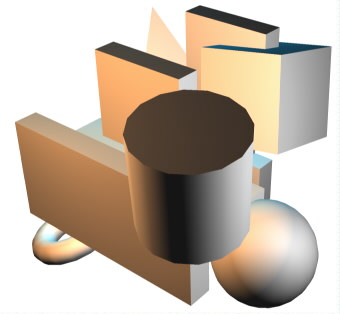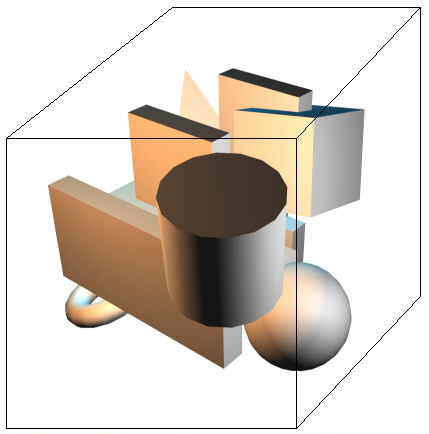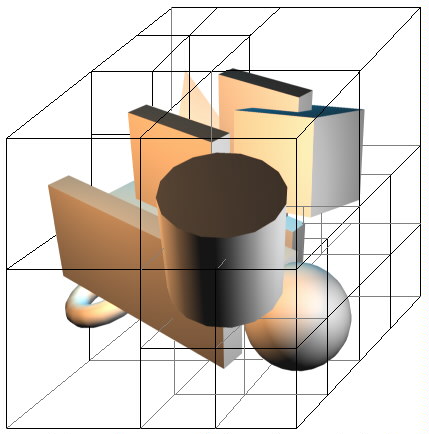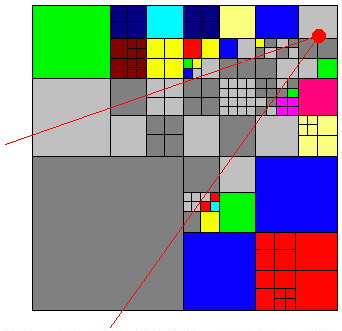八叉树(octree)简介(zz)
来源:互联网 发布:单片机晶振电路的作用 编辑:程序博客网 时间:2024/05/30 05:41
Introduction To Octrees
by Jaap Suter (13 April 1999)

I struggled with it since the very beginning of writing 3D engines and stillhave no satisfactory solution to it. The ideal visibility detection scheme would allowunlimited data, extremely dynamic worlds and would have zero overdraw. The first 3dengine which implements these three demands still has to be written.
The Z buffer for example allows dynamical worlds and even crossing faces, but itsuffers from immense overdraw. The BSP-tree on the other hand, if well implemented,has no overdraw at all but needs that much pre-processing that dynamical worlds are adefinite nono.
It wasn't until recently i first heard of the octree, and I must admit i was struckby it's simplicity. I never actually implemented this structure and therefore I willpresent no pseudo code at all. This explanation is merely an attempt to make it more clearto people who have never heard of it. Besides, if you really understand the structure,then implementation is a piece of cake.


Fig 1. Our little level.
In the picture I just built a simple level containing no more than 250 polys. Nowimagine a cube surrounding the world like in the next image:

Fig. 2. Our little level surrounded by a cube.
Now it isn't hard to see that this cube can be divided into eight smaller cubes,hence the name octree. Take a look at this picture:

Fig 3. Our little level with the surrounding cube subdivided.
Call the larger cube the parent and the smaller cubes the children. On their turn subdivideeach children into eight smaller cubes, and you will notice we are creating a tree where eachnode has eight children.
There is still one little problem left. When should we stop dividing cubes into smaller ones?There are two possible solutions. The first one is to stop when a cube has some size smaller thena fixed number. The second one is more common. You might have noticed that every child has lesspolygons then it's parent. The trick is to stop subdividing when the number of polygons in a cubeis smaller then some fixed number.

Where Q is the position of one corner of the cube. This are very easy equations and the allparent polygons can very easily be checked against them.
It could occur that a polygon crosses a cube boundary. Again two possible solution are athand. First of all we could clip the polygon against the cube, which is simple, because ofthe axis aligned boundarys. On the other hand we could put the polygon in all cubes it is in.This means that some cubes can contain the same polygons. In order to prevent us from drawingone poly more than one time we should have a flag on each polygon which will be set if the polyis drawn for the first time.
The implementation of an octree is very straight forward. I haven't done it myself yet,but I will soon. It is all matter of recursion. In order to construct a tree, the first thingyou should think of is recursion. Whether we are talking about binary trees, quad trees oroctrees, it doesnt matter, just build the darn thing recursively. So have a class definitionof one cubeNode and put the creation of the tree in it's constructor. In this constructor youwill call the constructor itself for smaller cubes.

We will do this in 2d, which therefore resembles a quadtree, but with some imaginationit can very easily be extended to 3d. Here we test the cubes (squares) against the viewingfrustrum. Take a look at the next picture:

Fig 4. An octree from the top and a viewing frustrum.
In this picture a colored square that has one color was dumped without checking it’s children. Asyou can see some squares had to be checked all the way to the final node, but some large squarescould be dumped at once. The colored squares are the ones that are outside the viewing frustrum andthe greyscale ones are the one inside the viewing frustrum. As you can see this is actually a worstcase scenario because the viewing frustrum crosses the middle of the surrounding square and thereforeall the four children have to be checked.
You could also apply the octree to many other things. Collision detection for example. Just checkin which cube your bounding sphere or box is and you will only have to check against those faces.There are many more examples.

Code clean, play Goldeneye and go vegetarian.
Jaap Suter a.k.a .........
原文链接http://www.flipcode.com/archives/Introduction_To_Octrees.shtml
- 八叉树(octree)简介(zz)
- OCTREE 简介
- 八叉树 Octree
- 八叉树 Octree
- OcTree 八叉树
- 八叉树 Octree
- 八叉树 Octree
- 八叉树Octree
- 八叉树-Octree
- 八叉树 Octree
- 八叉树 Octree
- 八叉树Octree
- 八叉树Octree
- 八叉树Octree
- 八叉树 octree
- 八叉树Octree原理
- Octree
- Octree
- 5分钟踢进TDD之门
- 递归拷贝所有子目录
- 一个用Spring AOP实现异常处理和记录程序执行时间的实例--邵京国
- 命令行参数解析(1)
- OpenID
- 八叉树(octree)简介(zz)
- 无法获取DataSet删除行的值的问题
- JUnit 入門(六) - 測試設備(Test fixture)
- arcsde9.2中text的存储类型问题(unicode,varchar and nvarchar)
- Web Beans Public Review Draft released
- GFS与RHCS安装记录
- 在存储过程中创建临时表
- 关于validate验证用户名是否存在的简易理解
- 计算两个日期的时间间隔


